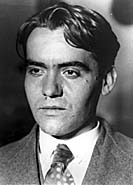|
|
|

Federico Garcia Lorca (1898-1936), Spain's greatest modern poet
and playwright, was born June 5, 1898 at Fuentevaqueros in the Spanish
province of Granada. He began writing poems in his late teens, reciting
many of them in the local cafes. In 1919 he left to study law at the
Residencia de Estudiantes in Madrid. There he met and became friends
with film director Luis Bunuel and painter Salvador Dali, among other
Spanish notables of his generation.
Lorca came to national prominence in 1927 when his play Mariana Pineda
was first staged. His initial book of poems Gypsy Ballads was published
the following year. During a trip abroad, which also took him to England
and Cuba, Lorca spent nine months in New York City beginning in June of
1929. His poems of that period were later collected in the volume
entitled Poet In New York.
In 1931 Spain became a Republic which gave hope to many, Lorca included,
that Spain's standard of living would be improved, its lliteracy reduced
and its culture more widely disseminated. Lorca became director of a
student theater company which toured small villages and in the face of
harassment by Fascist partisans presented the Spanish classics to the
peasants.
His first great play, the rural tragedy Blood Wedding, was staged in
1933. It was immensely popular in Spain and in Argentina which he
visited late that year. In 1935 he presented his second village tragedy,
Yerma, and completed his third, La Casa de Bernardo Alba.
Lorca spent much of early 1936 preparing Divan Del Tamarit, a cycle of
poems written in tribute to Granada's old Arab poets whom he had read in
translation. In July, shortly after the outbreak of the Spanish Civil
War, he went to vacation in Granada which had fallen to the fascists on
the first day of the conflict.
Although he had no political affiliations Lorca was known to be a friend
of left-wing intellectuals and an advocate of liberty. Apparently this
was enough of an indictment for those Falangists who arrested him on
August 16th. On or about August 18, 1936 Federico Garcia Lorca, along
with a white-haired schoolmaster and two anarchist bullfighters, was
driven to the village of Viznar at the foot of the Sierra Nevada
Mountains. There at dawn they were executed by a right-wing firing
squad. Although his remains are presumed to lie with those of hundreds
of fellow victims in a shallow trench among the grove of olive trees
adjacent to the Fuente Grande spring, the actual whereabouts of Lorca's
grave are unknown to this day.
--Rick Klaus Theis, 8/18/97
LINKS
- The
García Lorca Foundation
- An
organisation dedicated to the dissemination of the works of the poet
and dramatist.
- Mundo
Latino
- Poems of
García Lorca available on-line.
- Federico
García Lorca On-Line
- Biographical
information about Lorca
|
